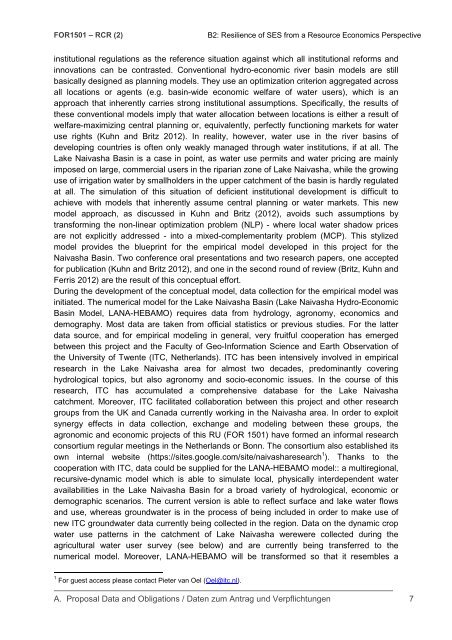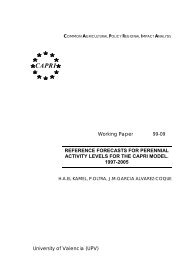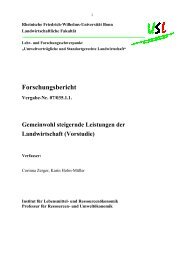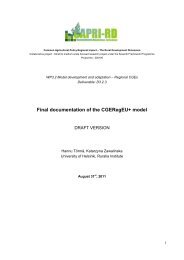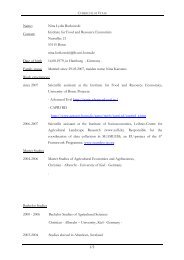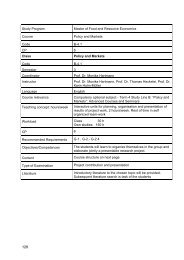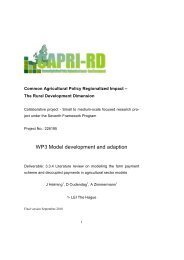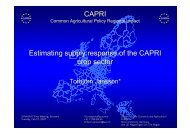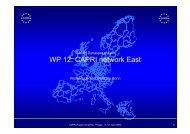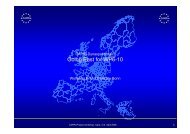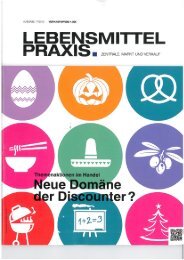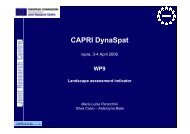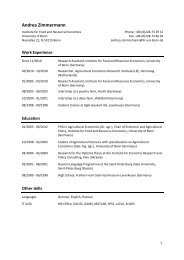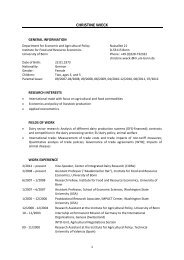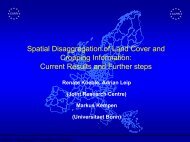Research proposal of sub-project B2 for second phase - Institut für ...
Research proposal of sub-project B2 for second phase - Institut für ...
Research proposal of sub-project B2 for second phase - Institut für ...
You also want an ePaper? Increase the reach of your titles
YUMPU automatically turns print PDFs into web optimized ePapers that Google loves.
FOR1501 – RCR (2)<br />
<strong>B2</strong>: Resilience <strong>of</strong> SES from a Resource Economics Perspective<br />
institutional regulations as the reference situation against which all institutional re<strong>for</strong>ms and<br />
innovations can be contrasted. Conventional hydro-economic river basin models are still<br />
basically designed as planning models. They use an optimization criterion aggregated across<br />
all locations or agents (e.g. basin-wide economic welfare <strong>of</strong> water users), which is an<br />
approach that inherently carries strong institutional assumptions. Specifically, the results <strong>of</strong><br />
these conventional models imply that water allocation between locations is either a result <strong>of</strong><br />
welfare-maximizing central planning or, equivalently, perfectly functioning markets <strong>for</strong> water<br />
use rights (Kuhn and Britz 2012). In reality, however, water use in the river basins <strong>of</strong><br />
developing countries is <strong>of</strong>ten only weakly managed through water institutions, if at all. The<br />
Lake Naivasha Basin is a case in point, as water use permits and water pricing are mainly<br />
imposed on large, commercial users in the riparian zone <strong>of</strong> Lake Naivasha, while the growing<br />
use <strong>of</strong> irrigation water by smallholders in the upper catchment <strong>of</strong> the basin is hardly regulated<br />
at all. The simulation <strong>of</strong> this situation <strong>of</strong> deficient institutional development is difficult to<br />
achieve with models that inherently assume central planning or water markets. This new<br />
model approach, as discussed in Kuhn and Britz (2012), avoids such assumptions by<br />
trans<strong>for</strong>ming the non-linear optimization problem (NLP) - where local water shadow prices<br />
are not explicitly addressed - into a mixed-complementarity problem (MCP). This stylized<br />
model provides the blueprint <strong>for</strong> the empirical model developed in this <strong>project</strong> <strong>for</strong> the<br />
Naivasha Basin. Two conference oral presentations and two research papers, one accepted<br />
<strong>for</strong> publication (Kuhn and Britz 2012), and one in the <strong>second</strong> round <strong>of</strong> review (Britz, Kuhn and<br />
Ferris 2012) are the result <strong>of</strong> this conceptual ef<strong>for</strong>t.<br />
During the development <strong>of</strong> the conceptual model, data collection <strong>for</strong> the empirical model was<br />
initiated. The numerical model <strong>for</strong> the Lake Naivasha Basin (Lake Naivasha Hydro-Economic<br />
Basin Model, LANA-HEBAMO) requires data from hydrology, agronomy, economics and<br />
demography. Most data are taken from <strong>of</strong>ficial statistics or previous studies. For the latter<br />
data source, and <strong>for</strong> empirical modeling in general, very fruitful cooperation has emerged<br />
between this <strong>project</strong> and the Faculty <strong>of</strong> Geo-In<strong>for</strong>mation Science and Earth Observation <strong>of</strong><br />
the University <strong>of</strong> Twente (ITC, Netherlands). ITC has been intensively involved in empirical<br />
research in the Lake Naivasha area <strong>for</strong> almost two decades, predominantly covering<br />
hydrological topics, but also agronomy and socio-economic issues. In the course <strong>of</strong> this<br />
research, ITC has accumulated a comprehensive database <strong>for</strong> the Lake Naivasha<br />
catchment. Moreover, ITC facilitated collaboration between this <strong>project</strong> and other research<br />
groups from the UK and Canada currently working in the Naivasha area. In order to exploit<br />
synergy effects in data collection, exchange and modeling between these groups, the<br />
agronomic and economic <strong>project</strong>s <strong>of</strong> this RU (FOR 1501) have <strong>for</strong>med an in<strong>for</strong>mal research<br />
consortium regular meetings in the Netherlands or Bonn. The consortium also established its<br />
own internal website (https://sites.google.com/site/naivasharesearch 1 ). Thanks to the<br />
cooperation with ITC, data could be supplied <strong>for</strong> the LANA-HEBAMO model:: a multiregional,<br />
recursive-dynamic model which is able to simulate local, physically interdependent water<br />
availabilities in the Lake Naivasha Basin <strong>for</strong> a broad variety <strong>of</strong> hydrological, economic or<br />
demographic scenarios. The current version is able to reflect surface and lake water flows<br />
and use, whereas groundwater is in the process <strong>of</strong> being included in order to make use <strong>of</strong><br />
new ITC groundwater data currently being collected in the region. Data on the dynamic crop<br />
water use patterns in the catchment <strong>of</strong> Lake Naivasha werewere collected during the<br />
agricultural water user survey (see below) and are currently being transferred to the<br />
numerical model. Moreover, LANA-HEBAMO will be trans<strong>for</strong>med so that it resembles a<br />
1 For guest access please contact Pieter van Oel (Oel@itc.nl).<br />
A. Proposal Data and Obligations / Daten zum Antrag und Verpflichtungen 7


